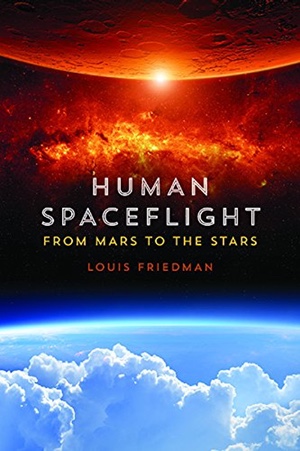Review: Human Spaceflightby Jeff Foust
|
| “I find no problem defining human exploration independently of the distance between the place being explored and the human,” Friedman writes. |
Does human spaceflight have a future beyond Mars? Yes and no, according to Louis Friedman, former executive director of The Planetary Society, in his new book Human Spaceflight: From Mars to the Stars. (Disclosure: the publishers asked me to review a draft manuscript of this book last year; this review is based on the final version just published.) Humans themselves, he argues, are unlikely to travel beyond Mars for the foreseeable future, and perhaps forever, but advances in technology will enable them to virtually explore the far reaches of the solar system, and even other solar systems, later this century and beyond.
The first part of this relatively slender book (less than 135 pages excluding notes and the index) is an optimistic assessment of the future of virtual human exploration. Advances in technology can help shrink spacecraft payloads into sizes small enough it becomes feasible to use solar sails, perhaps boosted by lasers or microwaves, to explore the distant solar system and, eventually, other stars. Friedman, who has worked on solar sail concepts since the 1970s at JPL and, later, the Planetary Society, offers a history of those efforts in the book, from the failed proposal for a solar sail mission to Halley’s Comet to the society’s LightSail-1 mission earlier this year.
Friedman doesn’t believe such robotic exploration is truly distinct from human exploration. “I find no problem defining human exploration independently of the distance between the place being explored and the human,” he writes. Advances in robotic technology are far outpacing advances in human space exploration technology, making it unlikely humans will be needed for future exploration missions. “Some find that negative, but that may be a failure of imagination,” he says, likening it to social networks that allow people to be in close touch with friends they never see in person.
However, Friedman believes there is a role for humans on Mars. That won’t be for scientific exploration alone, but instead for survival of the species: making humanity a “multi-planet species,” a goal advocated by, among others, SpaceX founder Elon Musk. “For all its hostility, it is the only other place we can both reach and adapt for living,” he writes of Mars. The timetables he offers, though, are less ambitious than those proposed by NASA, Musk, and others. He foresees human missions landing on Mars in the 2040s, with settlement to come much later, perhaps a century or more.
| The pace of those advances over time could change: a breakdown of Moore’s Law, for example, could slow the advance of computer technologies needed for advances in robotic missions, while a breakthrough in propulsion could accelerate (figuratively and literally) human spaceflight. |
That balance—humans to Mars, but no further—is likely to trigger plenty of debate and discussion. If robotic exploration is becoming more capable, perhaps it will be sufficient to answer our questions about Mars without going there ourselves. Survival of the species, in that case, could be assured though bases on the Moon or habitats in cislunar space, like the space colonies envisioned by Gerard K. O’Neill four decades ago. But if humans do make it to Mars and establish a foothold there, will they forever be satisfied with it, or will the asteroids, or maybe the moons of the outer solar system like Europa and Titan, beckon?
Those outcomes will depend on the advances in technology, for humans and for robotic exploration, in the decades to come. The pace of those advances over time could change: a breakdown of Moore’s Law, for example, could slow the advance of computer technologies needed for advances in robotic missions, while a breakthrough in propulsion could accelerate (figuratively and literally) human spaceflight. But based on reasonable extrapolations of current technology and policy, Human Spaceflight offers a logical vision of where humans will, and will not, go in the solar system.
